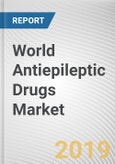Antiepileptic drugs market is segmented based on drug type and geography. Drug type segment is further categorized into two broad categories, namely first and second-generation antiepileptic drugs. Phenytoin, carbamazepine, oxycarbazepine and valproate from the first generation class, dominates the overall antiepileptics market. From the second-generation drugs, zonisamide, levetiracetam, and lacosamide are gaining popularity due to their tolerability and high efficacy. Geographically, global antiepileptic drugs market is segmented into North America, Europe, Asia-Pacific and LAMEA. North America and Europe dominates the global market due to extensive R&D efforts and presence of approved second-generation antiepileptics. Asia-pacific is the fastest growing market owing to widespread prevalence of epilepsy and better penetration of antiepileptic drugs. In-depth coverage of the global antiepileptic drugs market including drivers, restraints and opportunities would help professionals to better understand market behavior. Porter’s Five Forces analysis examines the competitive structure of the global antiepileptic drugs market and it would assist market strategists in their respective decision making process. Pinpointed analysis of geographic segments would help to identify opportunities for growth within the global antiepileptic drugs market.
KEY BENEFITS
This report offers the following benefits in particular:
In-depth coverage of the global antiepileptic drugs market including drivers, restraints and opportunities would help professionals to better understand market behavior
Porter’s Five Forces analysis examines the competitive structure of the global antiepileptic drugs market and it would assist market strategists in their respective decision making process
Pinpointed analysis of geographic segments helps to identify opportunities for growth within the global antiepileptic drugs market
Detailed study of the strategies of key leaders, partnerships and acquisitions in the global antiepileptic drugs market would be informative for professionals in the corporate sector
KEY MARKET SEGMENTS
The global antiepileptic drugs market is segmented into two major categories such as drug type and geography.
MARKET BY DRUG TYPE
First Generation AEDs
Phenytoin (Dilantin, Phenytek)
Carbamazepine (Carbatrol)
Oxycarbazepine (Trileptal)
Valproate (Depakote)
Topiramate (Topamax)
Ethosuximide (Zarontin)
Primidone (Mysoline)
Phenobarbital (Luminal)
Second Generation AEDs
Lamotrigine (Lamictal)
Pregabalin (Lyrica)
Rufinamide (Banzel/Inovelon)
Levetiracetam (Keppra)
Ezogabine/retigabine (Trobalt/Potiga)
Lacosamide (Vimpat)
Eslicarbazepine acetate (Aptiom)
Zonisamide (Zonegran)
Perampanel (Fycompa)
MARKET BY GEOGRAPHY
North America
Europe
Asia-Pacific
LAMEA
Methodology
The analyst offers exhaustive research and analysis based on a wide variety of factual inputs, which largely include interviews with industry participants, reliable statistics, and regional intelligence. The in-house industry experts play an instrumental role in designing analytic tools and models, tailored to the requirements of a particular industry segment. The primary research efforts include reaching out participants through mail, tele-conversations, referrals, professional networks, and face-to-face interactions.
They are also in professional corporate relations with various companies that allow them greater flexibility for reaching out to industry participants and commentators for interviews and discussions.
They also refer to a broad array of industry sources for their secondary research, which typically include; however, not limited to:
- Company SEC filings, annual reports, company websites, broker & financial reports, and investor presentations for competitive scenario and shape of the industry
- Scientific and technical writings for product information and related preemptions
- Regional government and statistical databases for macro analysis
- Authentic news articles and other related releases for market evaluation
- Internal and external proprietary databases, key market indicators, and relevant press releases for market estimates and forecast
Furthermore, the accuracy of the data will be analyzed and validated by conducting additional primaries with various industry experts and KOLs. They also provide robust post-sales support to clients.

LOADING...








